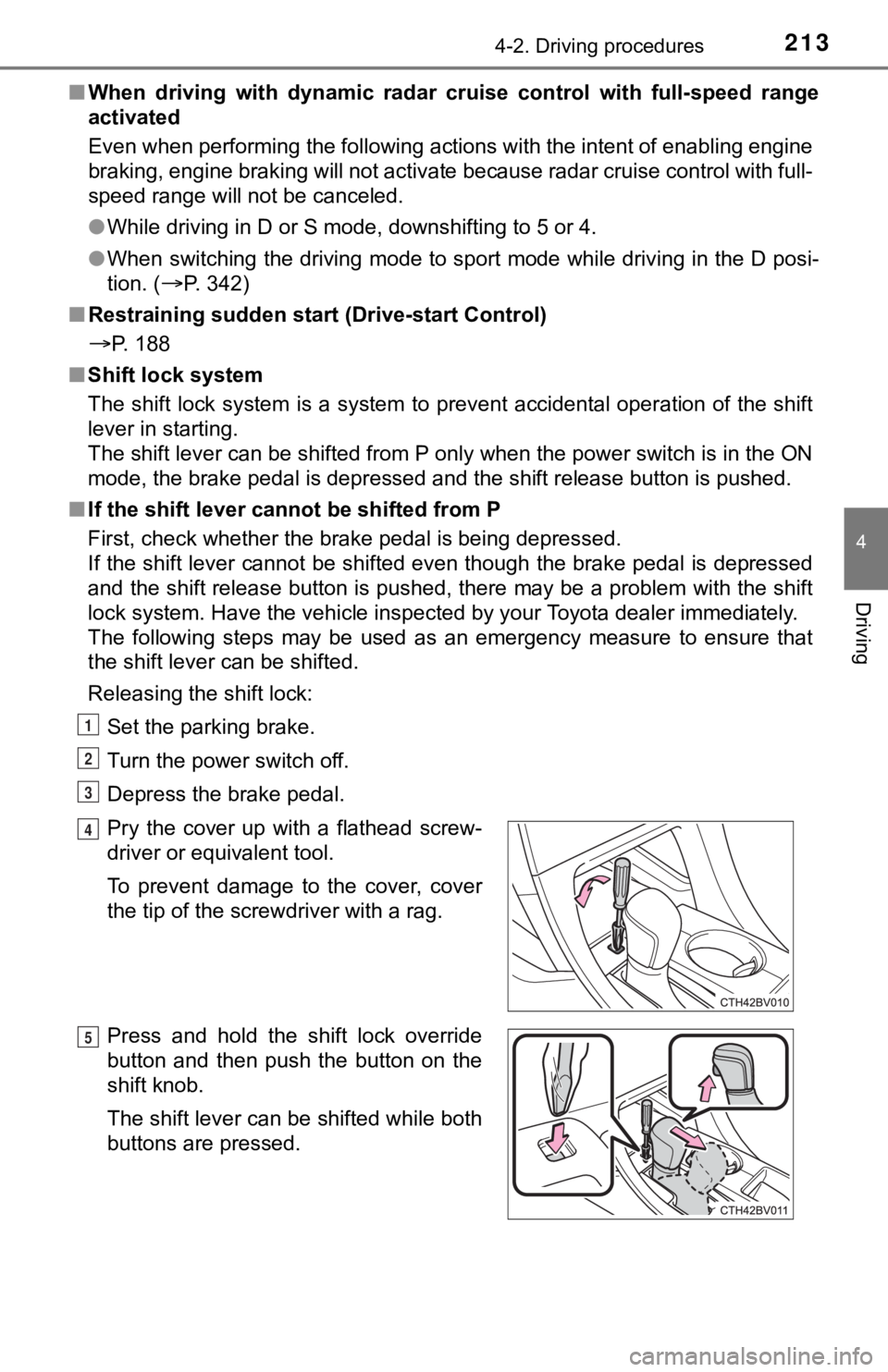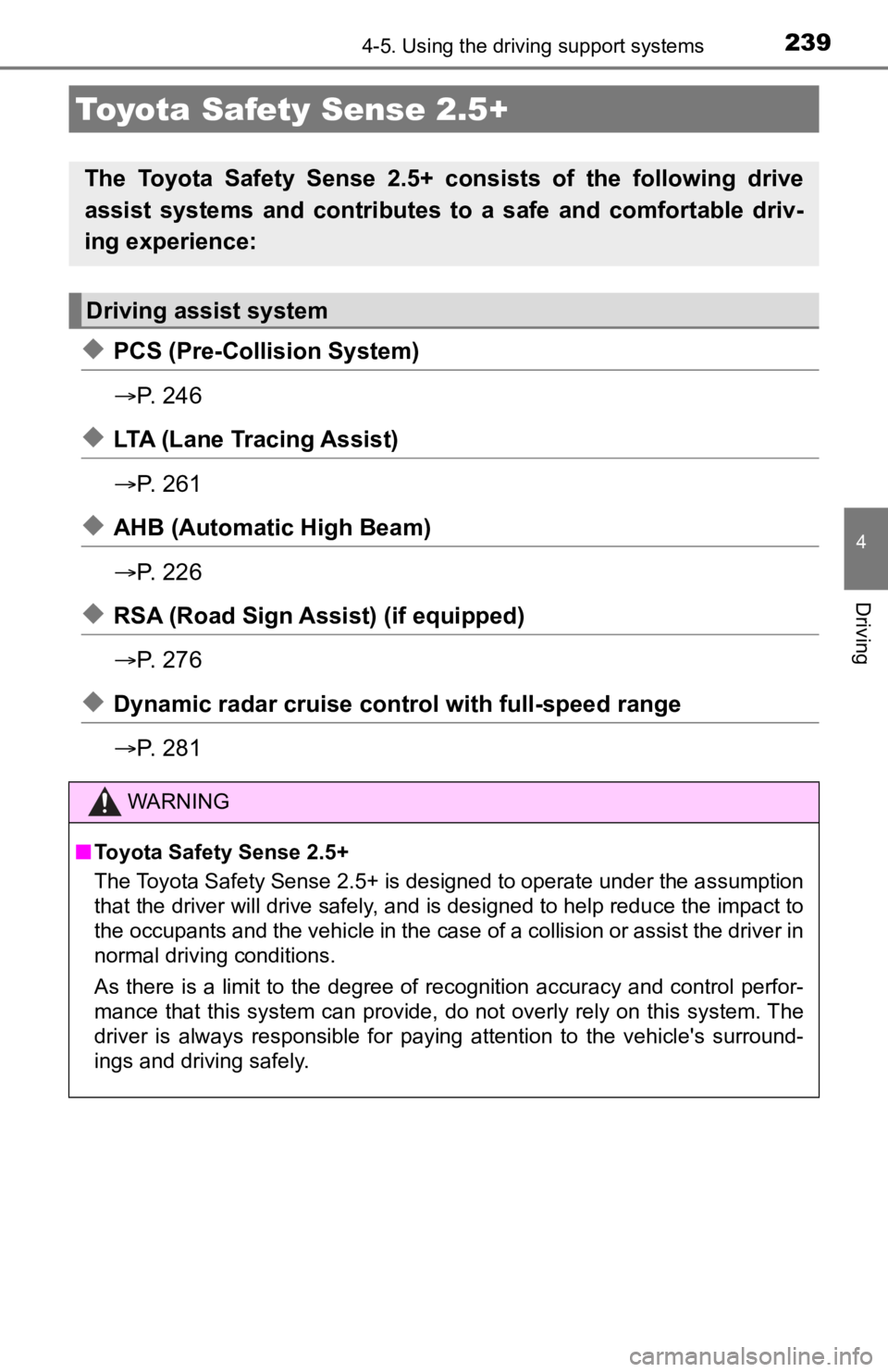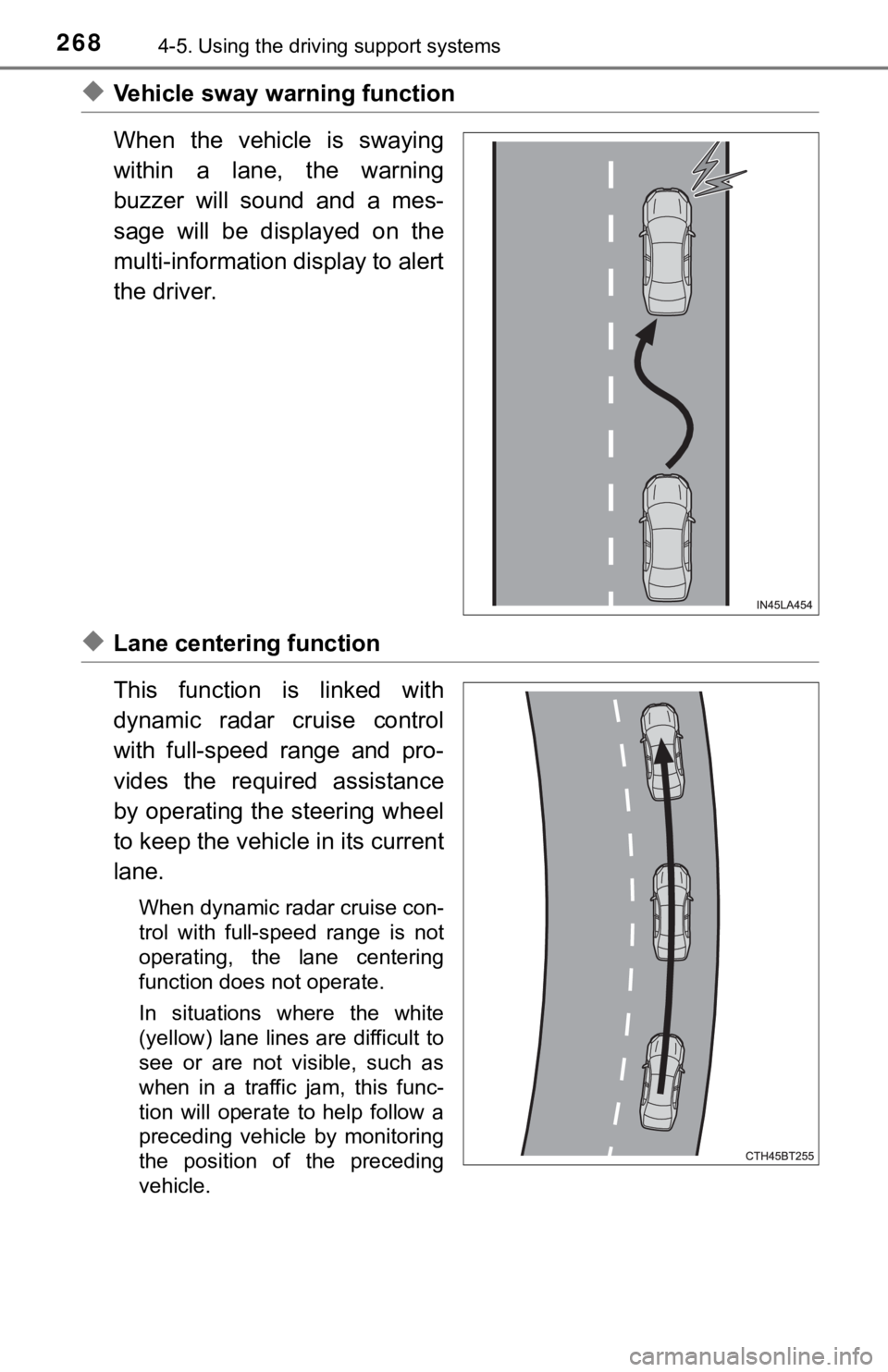2022 TOYOTA AVALON HYBRID cruise control
[x] Cancel search: cruise controlPage 185 of 584

185
4Driving
4-1. Before drivingDriving the vehicle ............. 186
Cargo and luggage ........... 194
Vehicle load limits ............. 197
Trailer towing..................... 198
Dinghy towing ................... 199
4-2. Driving procedures Power (ignition) switch ...... 200
EV drive mode .................. 206
Hybrid transmission........... 209
Turn signal lever................ 215
Parking brake .................... 216
Brake Hold ........................ 220
4-3. Operating the lights and wipers
Headlight switch ................ 222
AHB (Automatic High Beam) ............................. 226
Windshield wipers and washer ............................ 230
4-4. Refueling Opening the fuel tank cap .................................. 234 4-5. Using the driving
support systems
Toyota Safety Sense 2.5+...................... 239
PCS (Pre-Collision System)........................... 246
LTA (Lane Tracing Assist) ............................. 261
RSA (Road Sign Assist) ............................. 276
Dynamic radar cruise control with full-speed
range............................... 281
BSM (Blind Spot Monitor)........................... 297
• BSM function ................ 301
• RCTA function .............. 304
Rear Camera Detection function (vehicles with
panoramic view
monitor)........................... 309
Intuitive parking assist....... 313
Intelligent Clearance Sonar (ICS) ..................... 321
Driving mode select switches .......................... 342
Driving assist systems ...... 344
4-6. Driving tips Hybrid vehicle driving tips .................................. 351
Winter driving tips ............. 354
Page 188 of 584

1884-1. Before driving
■ECO Accelerator Guidance ( P. 109)
Eco-friendly driving may be achieved more easily by staying wit hin the zone
of Eco acceleration. Also, by staying within the zone of Eco ac celeration, it
will be easier to obtain a good Eco score.
● When starting off:
Gradually depress the accelerator pedal to stay within the zone of Eco accel-
eration and accelerate to the desired speed. By refraining from excessive
acceleration, a good eco start score will be obtained.
● When driving:
After accelerating to the desired speed, release the accelerator pedal and
drive at a stable speed while staying within the zone of Eco acceleration. By
staying within the zone of Eco acceleration, a good eco cruise score will be
obtained.
● When stopping:
By starting to release the accelerator pedal early before dece lerating, a good
eco stop score will be obtained.
■ Drive-Start Control (DSC)
When the TRAC is turned off ( P. 346), sudden start restraint control also
does not operate. If your vehicle have trouble escaping from th e mud or fresh
snow due to sudden start restraint control operation, deactivat e TRAC (P.
346) so that the vehicle may become able to escape from the mud or fresh
snow.
■ Breaking in your new Toyota
To extend the life of the vehicle, observing the following prec autions is recom-
mended:
● For the first 186 miles (300 km):
Avoid sudden stops.
● For the first 621 miles (1000 km):
• Do not drive at extremely high speeds.
• Avoid sudden acceleration.
• Do not drive continuously in low gears.
• Do not drive at a constant speed for extended periods.
■ Operating your vehicle in a foreign country
Comply with the relevant vehicle registration laws and confirm the availability
of the correct fuel. ( P. 526)
■ Eco-friendly driving
P. 100, 126
Page 213 of 584

2134-2. Driving procedures
4
Driving
■When driving with dynamic radar cruise control with full-speed range
activated
Even when performing the following actions with the intent of e nabling engine
braking, engine braking will not activate because radar cruise control with full-
speed range will not be canceled.
● While driving in D or S mode, downshifting to 5 or 4.
● When switching the driving mode to sport mode while driving in the D posi-
tion. (
P. 342)
■ Restraining sudden start (Drive-start Control)
P. 188
■ Shift lock system
The shift lock system is a system to prevent accidental operation of the shift
lever in starting.
The shift lever can be shifted from P only when the power switc h is in the ON
mode, the brake pedal is depressed and the shift release button is pushed.
■ If the shift lever cannot be shifted from P
First, check whether the brake pedal is being depressed.
If the shift lever cannot be shifted even though the brake peda l is depressed
and the shift release button is pushed, there may be a problem with the shift
lock system. Have the vehicle inspected by your Toyota dealer i mmediately.
The following steps may be used as an emergency measure to ensu re that
the shift lever can be shifted.
Releasing the shift lock:
Set the parking brake.
Turn the power switch off.
Depress the brake pedal.
Pry the cover up with a flathead screw-
driver or equivalent tool.
To prevent damage to the cover, cover
the tip of the screwdriver with a rag.
Press and hold the shift lock override
button and then push the button on the
shift knob.
The shift lever can be shifted while both
buttons are pressed.
1
2
3
4
5
Page 239 of 584

239
4
Driving
4-5. Using the driving support systems
◆PCS (Pre-Collision System)
P. 2 4 6
◆LTA (Lane Tracing Assist)
P. 2 6 1
◆AHB (Automatic High Beam)
P. 2 2 6
◆RSA (Road Sign Assi st) (if equipped)
P. 2 7 6
◆Dynamic radar cruise control with full-speed range
P. 2 8 1
Toyota Safety Sense 2.5+
The Toyota Safety Sense 2.5+ c onsists of the following drive
assist systems and contributes t o a safe and comfortable driv-
ing experience:
Driving assist system
WARNING
■ Toyota Safety Sense 2.5+
The Toyota Safety Sense 2.5+ is designed to operate under the assumption
that the driver will drive safely, and is designed to help reduce the impact to
the occupants and the vehicle in the case of a collision or assist the driver in
normal driving conditions.
As there is a limit to the degree of recognition accuracy and control perfor-
mance that this system can provide, do not overly rely on this system. The
driver is always responsible for paying attention to the vehicle's surround-
ings and driving safely.
Page 261 of 584

2614-5. Using the driving support systems
4
Driving
While driving on a road with clear white (yellow) lane lines, the LTA
system warns the driver if the vehicle may deviate from the cur rent
lane or course
*, and also can slightly operate the steering wheel to
help avoid deviation from the lane or course
*. Also, while the dynamic
radar cruise control with full-speed range is operating, this s ystem will
operate the steering wheel to maintain the vehicle’s lane posit ion.
The LTA system recognizes white
(yellow) lane lines or a course
*
using the front camera. Addition-
ally, it detects preceding vehicles
using the front camera and radar.
*: Boundary between asphalt and the side of the road, such as grass, soil, or a curb
LTA (Lane Tracing Assist)
Summary of functions
WARNING
■ Before using LTA system
● Do not rely solely upon the LTA system. The LTA system does not auto-
matically drive the vehicle or reduce the amount of attention t hat must be
paid to the area in front of the vehicle. The driver must always assume full
responsibility for driving safely by paying careful attention to the surround-
ing conditions and operating the steering wheel to correct the path of the
vehicle. Also, the driver must take adequate breaks when fatigued, such
as from driving for a long period of time.
● Failure to perform appropriate driving operations and pay careful attention
may lead to an accident, resulting in death or serious injury.
Page 268 of 584

2684-5. Using the driving support systems
◆Vehicle sway warning function
When the vehicle is swaying
within a lane, the warning
buzzer will sound and a mes-
sage will be displayed on the
multi-information display to alert
the driver.
◆Lane centering function
This function is linked with
dynamic radar cruise control
with full-speed range and pro-
vides the required assistance
by operating the steering wheel
to keep the vehicle in its current
lane.
When dynamic radar cruise con-
trol with full-speed range is not
operating, the lane centering
function does not operate.
In situations where the white
(yellow) lane lines are difficult to
see or are not visible, such as
when in a traffic jam, this func-
tion will operate to help follow a
preceding vehicle by monitoring
the position of the preceding
vehicle.
Page 273 of 584

2734-5. Using the driving support systems
4
Driving
• The dynamic radar cruise control with full-speed range is operating in
vehicle-to-vehicle distance control mode.
• Width of traffic lane is approximately 10 to 13 ft. (3 to 4 m).
• Turn signal lever is not operated.
• Vehicle is not being driven around a sharp curve.
• No system malfunctions are detected. ( P. 275)
• Vehicle does not accelerate or decelerate by a fixed amount or more.
• Steering wheel is not operated with a steering force level suitable for
changing lanes.
• ABS, VSC, TRAC and PCS are not operating.
• TRAC or VSC is not turned off.
• Hands off steering wheel warning is not displayed. ( P. 2 7 4 )
• The vehicle is being driven in the center of a lane.
• Steering assist function is not operating.
■ Temporary cancelation of functions
●When operation conditions are no longer met, a function may be temporarily
canceled. However, when the operation conditions are met again, operation
of the function is automatically restored. ( P. 272)
● If the operation conditions ( P. 272) are no longer met while the lane cen-
tering function is operating, the buzzer may sound to indicate that the func-
tion has been temporarily canceled.
■ Steering assist function/lane centering function
●Depending on the vehicle speed, lane departure situation, road conditions,
etc., the driver may not feel the function is operating or the function may not
operate at all.
● The steering control of the function is overridden by the drive r’s steering
wheel operation.
● Do not attempt to test the operation of the steering assist fun ction.
■ Lane departure alert function
●The warning buzzer may be difficult to hear due to external noi se, audio
playback, etc.
● If the edge of the course
* is not clear or straight, the lane departure alert
function may not operate.
● Vehicle with BSM: It may not be possible for the system to determine if there
is a danger of a collision with a vehicle in an adjacent lane.
● Do not attempt to test the operation of the lane departure aler t function.
*: Boundary between asphalt and the side of the road, such as gra ss, soil, or
a curb
Page 281 of 584

2814-5. Using the driving support systems
4
Driving
In vehicle-to-vehicle distance control mode, the vehicle automatically
accelerates, decelerates and st ops to match the speed changes o f the
preceding vehicle even if the acc elerator pedal is not depressed. In
constant speed control mode, t he vehicle runs at a fixed speed.
Use the dynamic radar cruise control with full-speed range on f ree-
ways and highways.
● Vehicle-to-vehicle distance control mode ( P. 285)
● Constant speed c ontrol mode (P. 292)
■Meter display
Multi-information display
Set speed
Indicators
■Operation switchesVehicle-to-vehicle distance
switch
“+ RES” switch
Cruise control main switch
Cancel switch
“- SET” switch
Dynamic radar cruise control with full-
speed range
Summary of functions
System Components
1
2
3
1
2
3
4
5